In today’s world, coding is a massive part of business and individual projects, and it’s one of the most time-consuming tasks.
If you use and review large amounts of code, you can benefit from a code review tool.
This article will give you an overview of the 13 best code review tools for 2022, plus some helpful information about why code review is essential.
The Best Code Review Tools (Overview)
- Bitbucket
- GitHub
- Gerrit
- Azure DevOps
- GitLab
- Helix Swarm
- JetBrains Space
- Upsource
- Crucible
- CodeScene
- Reviewable
- Veracode
- Rhodecode
An Overview of Code Review Tools
Before we dive into the pros, cons, and pricing of the best code review tools available, let’s quickly discuss code review tools and how they can help you.
What Is a Code Review Tool?
A code review tool is a software or platform that automates most of the actions performed in a code review.
Developers and coders often spend a considerable amount of their working time reviewing and fixing their code to ensure it functions properly and doesn’t have any bugs.
But this review is tedious and lengthy.
Code review tools help to reduce a developer’s workload so they can focus on the code.
Code review tools can integrate a project’s development cycle and even begin reviewing code before it’s merged into a codebase.
A code review tool is similar to Grammarly, which automates editing for grammar, spelling, clarity, and more in writing.
Why Are Code Review Tools Important?
Code review tools are immensely critical to the success of a product.
Code review itself is crucial to triumphant programming and development.
But as mentioned, code review is incredibly time-consuming.
Reviewing a code can even take longer than writing the code, slowing down production time and product launches.
To help speed up the process, most major companies use code review tools, which automate a lot of the development process.
These tools allow developers to focus on more coding and perfecting the product, so code review tools are essential in running a successful coding endeavor.
Any business or individual who writes significant amounts of code should utilize an effective code review tool.
Best Code Review Tools
Code review tools are important, but they’re not all stellar.
To help you choose the ideal tool for your projects and needs, we’ve rounded up the 13 best code review tools for 2022.
Check out the pros, cons, pricing, and more information about each of these tools so you can use the best one for you.
Bitbucket
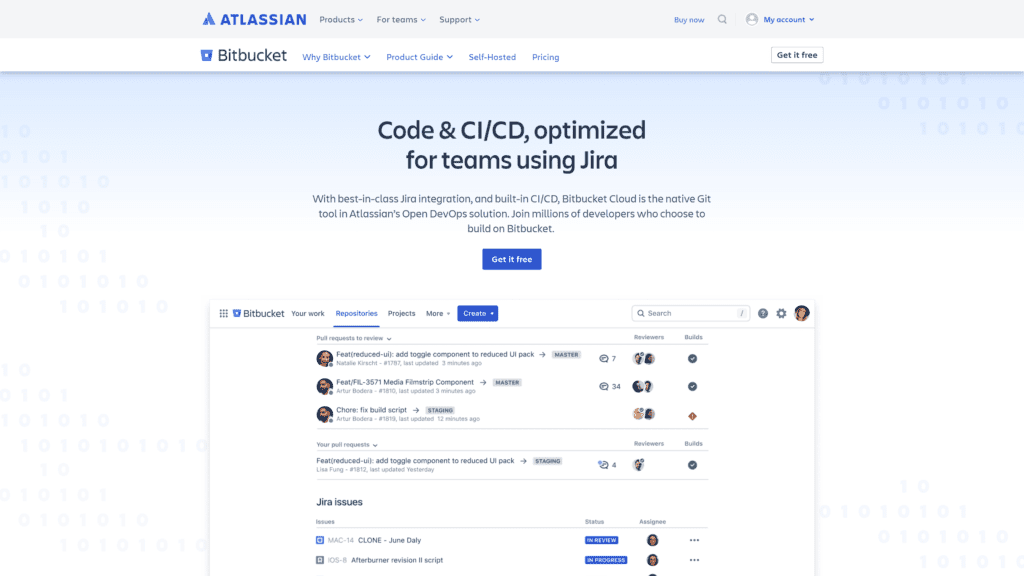
Overview
Bitbucket is the best code review tool for teams who collaborate in big groups and want to review their code thoroughly and safely.
They have added security measures so you can ensure your code and work are protected from cybercriminals.
With several stable and effective features, this code review tool is one of the most reliable options.
★★★★★
Best Overall
Notable Features:
- CI/CD: You can set up CI/CD in two steps to work alongside your code.
The continuous visibility from backlog to deployment gives you the best vantage for reviewing code. - Cloud Security: Bitbucket uses the Atlassian Cloud, so you can feel confident that your data is safe and secure.
- DevSecOps: This feature adds another layer of protection to your team’s work from development to deployment.
- Code Review: Of course, the code-first interface makes it easy to find bugs quickly, collaborate, and merge with other projects, people, or integrations.
Pros
- Excellent integration with Jira
- Strong security with Atlassian
- User-friendly interface
- Code review and code push
- Easy continuous integration
Cons
- Unattractive project pages
- Some code conflicts with merging
- Lack of notifications
Is Bitbucket Hard To Use?
One of the reasons Bitbucket tops this list is because it’s easy to use.
It has an intuitive user interface and clear pages that allow you to navigate through the features and review your code effectively.
Pricing & Plans
Bitbucket has three pricing options: free, standard, and premium.
Free: Many coders love the free plan with Bitbucket because you can still perform merge checks, integrations, unlimited pull request reviewers, CI/CD, and more.
The most limiting aspects are the 50 minutes of build time per month and the limit of five users per account.
Standard: The Standard plan is the most popular because it offers plenty of storage, build time, and unlimited code insight integrations.
It costs $3 for every user on the account per month, so it can be as low as $3 if you review the code on your own.
Premium: The Premium plan is for people who do a lot of coding and need to have unlimited resources to review it.
It costs $6 per user but automatically features five users, so it costs $30 per month.
The more users you add, the less the cost is per user.
Our Take
Bitbucket is one of the most flexible code review tools as far as piercing and usability.
Whether you have tons of code to review each week or just want to review a single project, Bitbucket can work superbly for your needs.
GitHub

Overview
GitHub is an excellent code review tool for developers who want to perfect their code.
It has a wide array of features and a prompt customer service team.
Overall, it’s one of the best code review tools for companies of any size or individuals developing code.
★★★★☆
Best For Developers
Notable Features:
- Codespaces: This feature gives you a Visual Code Studio, making it easy to review code in a standardized dev environment, helping to reduce variables and bugs.
- Packages: GitHub packages allow you to securely publish and absorb packages within your organization, so you can authenticate code and launch it faster.
- Copilot: Copilot is ideal for developers who work with an editor to suggest code and changes in real time.
Pros
- Vulnerability scanning
- Useful automation
- Ability to revert code
- Private and public repository
- Excellent team collaboration tools
Cons
- Difficult to handle merge conflicts
- Poor PullRequest code tool
- Poor labeling
Is GitHub Hard To Use?
For the most part, GitHub is easy.
However, certain features can be troublesome, and it can be difficult to do simple tasks like deleting a folder or resolving a merge conflict.
Pricing & Plans
GitHub also has three piercing options: free, team, or enterprise.
Free: For $0, you can use GitHub for public repositories and almost all the GitHub features, making it ideal for individuals or smaller organizations.
Team: Team is the most popular option, starting at $4 per month.
It offers almost everything on GitHub, excluding a few fancy AI features.
Enterprise: Enterprise is $21 a month and is best for large businesses that perform lots of code reviews.
With this plan, you also get premium customer support.
Our Take
GitHub is excellent for developers who understand code review, as it can have a complex interface and a lack of labeling.
However, it has so many fantastic features that developers love and very reasonable pricing plans.
Gerrit
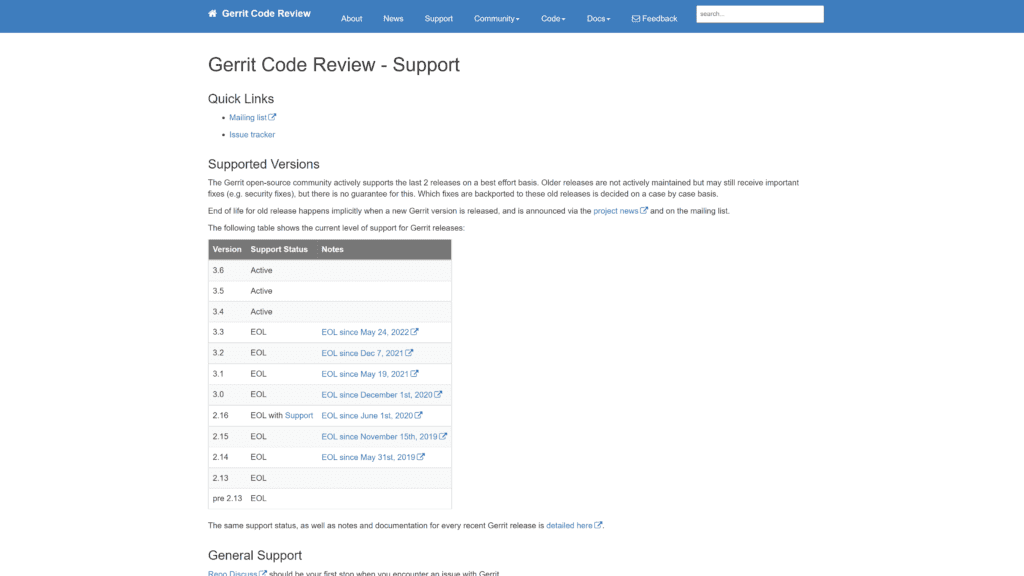
Overview
Gerrit is a pre-commit self-hosted code review tool that uses Git as its host server.
The tool works well with collaborating teams who need to communicate on code changes.
★★★★☆
Best For Git Users
Notable Features:
- Code Discussions: Boost your team’s collaboration and code merging by creating group discussions where everyone can communicate.
- Managed Workflows: Gerrit has deeply integrated access controls that allow you to manage your code projects and your team as you see fit.
- Custom Dashboards: These help you to display your code and use the tools in a way that makes sense to you.
Each section is entirely configured from the URL you choose.
Pros
- Open source code review
- Excellent workflow tools
- Clean repository story
- Unlimited repository support
- Comparison dashboards
- Integration with Jenkins
Cons
- Lengthy publishing process
- Only works with Git
- Slow to make changes and updates
Is Gerrit Hard To Use?
Gerrit has a user-friendly interface, but what can make it difficult to use is the slow processes.
For publishing and integrations, the slowness can make it hard to stay on top of things.
Pricing & Plans
Rather than subscription and pricing plans, Gerrit sells its software for download.
However, their pricing information is elusive, so you need to contact them to get a quote for your software needs.
Our Take
While Gerrit is a great tool, they don’t keep their software up-to-date and do not offer transparent pricing.
But the features and many integration capabilities still make it a popular choice and number three on this list.
Azure DevOps
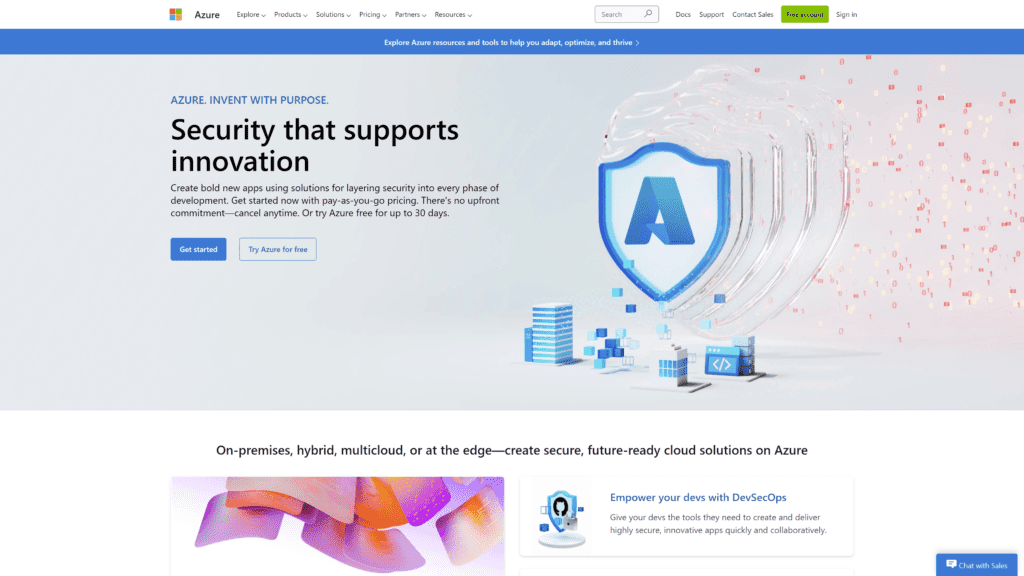
Overview
Azure DevOps is a code review tool run by Microsoft, making it one of the most trusted code review tools.
The code review tool has loads of helpful features and a user-friendly interface that makes it easy to navigate for both newbies and experienced coders.
★★★★☆
Best User-Interface
Notable Features:
- Pipelines: This is the best feature of the tool, as it lets you build, test, and deploy using CI/CD.
You can do this in any language, with any platform, and on any cloud. - Repos: The Azure Repos gives you unlimited access to cloud-hosted private Git repositories and advanced file management tools.
- Artifacts: This is a feature that helps you create packages to host and share with your team with a single click.
- Test Plans: The Azure test plans help you to test and ship new projects with confidence so that you can explore the functionality and manual capabilities.
Pros
- Excellent UI and navigation
- Extra tools for deployment
- Prompt shipping and launching
- Decent collaboration capabilities
- Modern technology and consistent updates
Cons
- Complex pricing plans
- Difficulty with third-party plugins
- Lack of notifications
Is Azure DevOps Hard To Use?
No, the best part of Azure DevOps is how simple it is to use.
The navigation is straightforward and clear.
Pricing & Plans
Azure DevOps has complicated pricing plans, and the best way to determine how much it will cost you is to request a pricing quote from Azure.
There is also a pricing calculator that can help you ballpark what the cost will be.
Our Take
Our take on Azure DevOps is that it’s ideal for beginners who don’t have loads of developers and expert coders on their team.
Azure DevOps makes it easy for everyone to review their code and optimize it.
The main downside of Azure is not knowing the cost, which is often higher than other code review tools.
GitLab
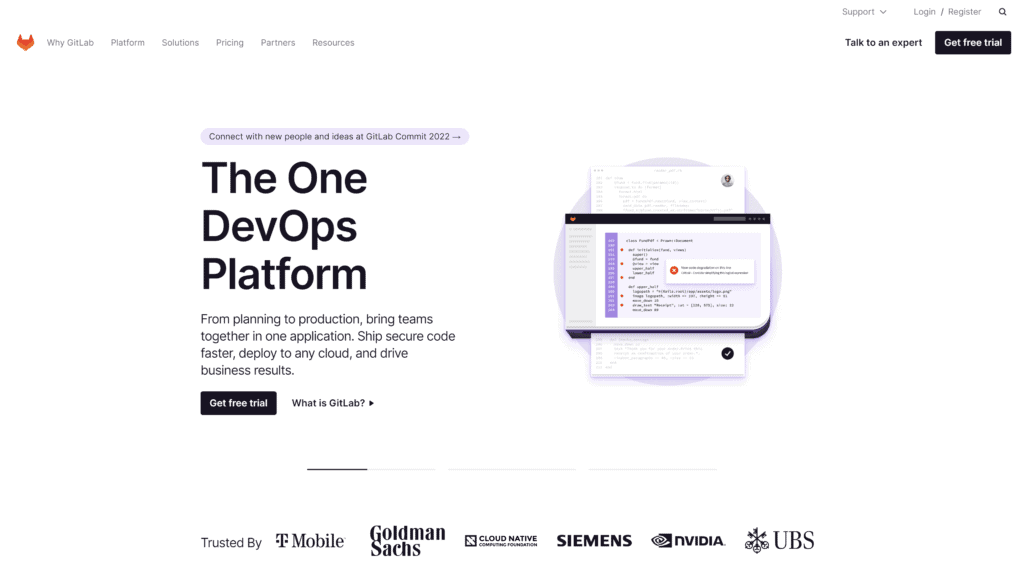
Overview
GitLab is an excellent code review tool for the planning and production of important projects.
It brings teams together in one DevOps platform and application.
They focus on secure shipping, fast deployment, seamless cloud uploading, and more to make your business more successful.
★★★★☆
Best For Big Businesses/Teams
Notable Features:
- Team Planning: The team planning features of GitLab are unmatched, offering custom project templates, tracked changes, chats, problem analytics, time estimations, project boards, milestone lists, assignee lists, and more.
- Source Code Management: The source code management feature lets various team members have version control to accelerate collaborations.
It helps people stay on top of their designated tasks and keep everything organized. - Epic and Issue Boards: The project board improves collaboration and communication.
It gives you one location where all members can track and review changes made by team members. - Continuous Integration and Delivery: With this feature, software delivery is easy to repeat and complete on-demand.
It helps automate a lot of work that would otherwise take up employee time.
Pros
- Impeccable collaboration capabilities
- Clear and accessible project boards
- Automated workflows and code delivery
- Efficient and agile functionality
- Everything a developer needs in one place
Cons
- Sometimes interface lags
- Lack of security in low plans
- Overwhelming for individuals or small businesses
Is GitLab Hard To Use?
While some features can be a bit tough to use, as certain code merges, GitLab is generally easy to use.
Most users report a bit of a learning curve, but once you get used to it, it’s a super useful tool.
Pricing & Plans
GitLab’s pricing plans are similar to many other code review tools.
There are three plans: free, premium, and ultimate.
Free: With the free plan, you get 5GB of storage, 10GB transfer per month, 400 CI/CD minutes, and five users per account.
Premium: It’s $19 a month for the premium plan, and you get more storage, CI/CD minutes, and transfers. Plus, you get faster code reviews, customer support, and agile planning.
Ultimate: This plan is $99 a month and comes with everything GitLab has to offer, with loads of storage, advanced, customer support, and free guest users.
Our Take
GitLab is hands down the best choice for massive teams of companies.
It works seamlessly between different integrations and can help keep large teams on the same page, even if they work remotely.
But this code review can be expensive and over-the-top for individual developers or smaller teams.
Helix Swarm

Overview
Helix Swarm is a highly scalable code review tool and DevOps solution that delivers dynamic testing, risk management, and intelligent collaboration.
Their goal is to give free code review software to companies in need, reducing the risk of code failure.
They want to help people create optimal code for whatever they need.
★★★☆☆
Best Free Download
Notable Features:
- Open Resources: To help you improve your code and develop the perfect product, you can learn tons of information from Helix Swarm’s open resources, which include webinars, live events, blogs, and courses.
- Expert Consultants: Unlike most other code review tools, Helix Swarm has live consultants and experts to help you work through any code review or launching issues you may encounter.
- Helix TeamHub: The TeamHub is excellent for source code repository hosting between collaborators. It also hosts source codes from many different integrations, like Mercurial, SVN, and Git.
Pros
- Consulting services
- Intelligent integrations
- Simple CLI scripting
- Easy-to-use web portal
- Fast reviewing and publishing
- Fantastic customer support
Cons
- Poor account management
- Lack of prompt updates for bugs
- Takes a while to install
Is Helix Swarm Hard To Use?
If you go in blind, Helix Swarm is hard to use.
However, the many training courses, consultants, and customer support representatives can help you navigate and use the software with ease.
Pricing & Plans
Helix Swarm is a completely free code review software that you can download and use.
But it may not be free forever, so download it soon!
Our Take
If you want a code review tool for free, Helix Swarm is the best option.
Despite being free, it has helpful features and a top-notch customer support team that can help you review your code and teach you more about developing if you’re a newbie.
JetBrains Space

Overview
JetBrains Space with Git hosting is an all-in-one platform for team collaboration and successful solutions when reviewing code.
It can integrate software development, team management, and project communications in a central location.
With Git hosting, CI/CD pipelines, and effective automation, JetBrains is one of the best code review tools.
★★★☆☆
Best for Organization
Notable Features:
- Guest Users: Most features of JetBrains Space are the same as other code review tools.
But the guest user option is unique, allowing you to invite temporary developers to the code review. - Cloud Dev Environments: Cloud Dev Environments allow you to build a remote development process, so it acts as a template for other environments.
This can speed up code review and make the project easier for your team. - Package Management: You can use package repositories in your CI/CD pipelines right from your local machine.
And it’s easy to share packages, files, and products with different integrations.
Pros
- All-in-one platform design
- Seamless collaboration
- Plenty of space for apps and integrations
- Easy team management
- Git repositories management
- Easy-to-use interface
Cons
- Difficult installation
- More expensive
- Hidden fees
Is JetBrains Space Hard To Use?
Once you get the software installed and updated, the system is easy to use.
There can be a slight learning curve, but most find it intuitive and clear.
Pricing & Plans
There are four pricing plans you can choose from: free, team, organization, and enterprise.
Free: This plan is free and offers enough features and storage for smaller businesses or individual coding projects, but not ideal for big teams.
Team: The Team plan is $10 per month for each user and comes with twice as much storage as the free plan.
This plan is perfect for medium-sized teams with moderate coding projects.
Organization: This plan is the most popular and gives you the most bang for your buck.
It costs $25 a month per user and has unlimited applications, endless hibernated dev environments, custom issue fields, and searchable messages.
Enterprise: The Enterprise plan works for bigger businesses, as it includes all product packs, unlimited applications, and tons of storage.
It costs $125 a month per active user, so it’s costly compared to other options.
Our Take
Our take on this code review tool is that it’s a mid-shelf option but with a top-shelf price.
While this code review tool is excellent, it does not offer any significant features that other code review tools can offer at a lower price.
Upsource
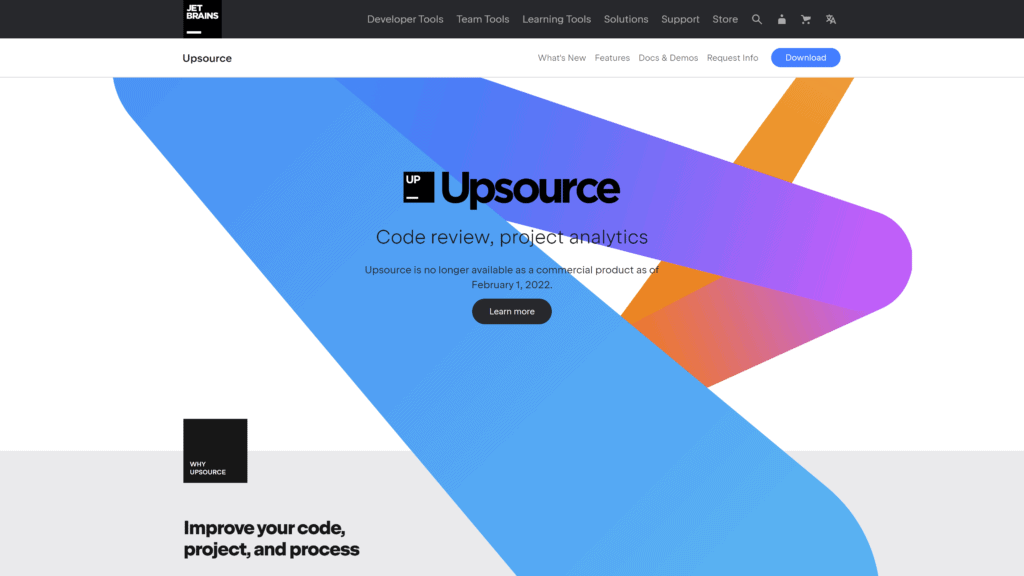
Overview
Upsource is an affordable and modern code review tool under the same company as JetBrains.
Most people associate these two code review tools together, but they do have some differences worth mentioning.
★★★☆☆
Best For Finding Coding Mistakes
Notable Features:
- Project-wide Risk Assessment: This feature helps you to distribute responsibility effectively to your team, allowing people to review each other’s code freely.
- Design Flaw Detector: With this feature, you can easily find parts of the project that need a developer’s attention to fix hotspots, abandoned files, and interface mistakes.
- Easy to Review Changes: With the IDE feature, you can easily participate in team discussions and review changes to the code to track progress and consistency.
Pros
- Event webinars
- Early access to new review technology
- Industry reports
- Affordable
- Academic licensing options
- Collaboration tools
Cons
- Lack of customer support
- Simple features
- Excessive notifications
Is Upsource Hard To Use?
No, Upsource is one of the easier code review tools to use, especially for people with little to no experience with coding or developing.
Pricing & Plans
To determine the cost of Upsource, you need to contact their team for a quote. However, many of the features and downloads are free!
Our Take
Overall, Upsource seems to be one of the best code review tools for finding mistakes and bugs.
While all code review tools help to do this, Upsource is the best one for fixing major, glaring problems that you may struggle to understand.
Crucible
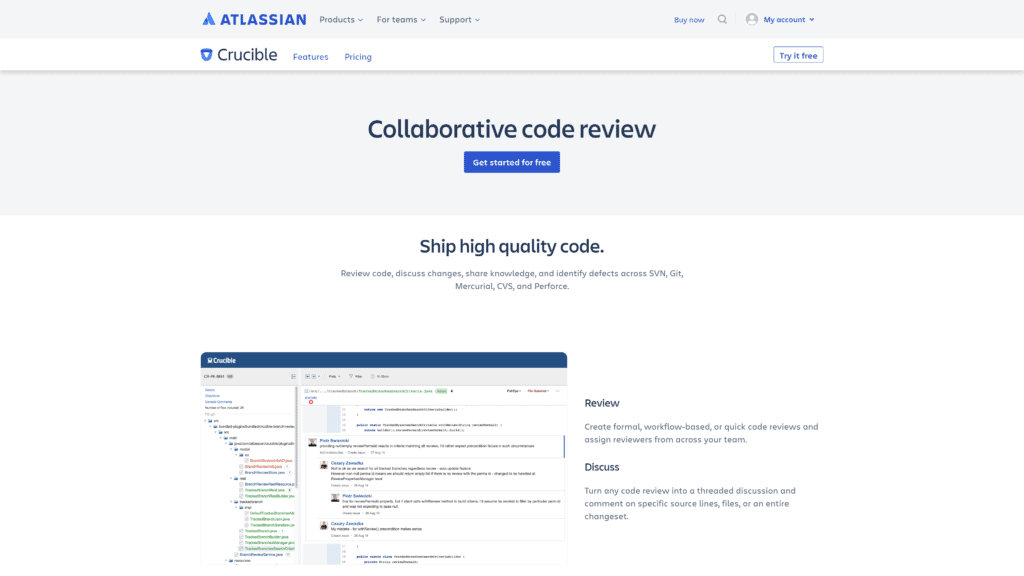
Overview
Crucible is another code review tool from the power Atlassian company, meaning it can easily integrate with many different platforms.
Crucible is all about helping you achieve the highest-quality code you can, no matter what kind of project you have.
★★★☆☆
Best For Communication
Notable Features:
- Inline Discussions: With Inline discussions, you can collaborate with your team in the comments right beside your code using threads, mentions, and tags!
- Activity Streams: With the activity streams, you can follow what happens throughout the project’s progression.
It will show recent comments along with review updates. - Code Review Tool: Their superb code review tool helps catch major defects, improve code architecture, and execute desired improvements within the workflow.
Pros
- Excellent communication avenues
- Strict tracking of changes and progress
- Pre-commit reviews
- Jira software integration
- Real-time notifications
- Charts and reports
Cons
- Not ideal for individuals
- Not a subscription platform
- Unresponsive customer support
Is Crucible Hard To Use?
No, Crucible is one of the easiest code review tools to use, especially when working in large teams.
It displays everything clearly, and you can customize your dashboard.
Pricing & Plans
Crucible has two pricing options: Small teams and Growing teams.
Both are one-time payments, and some people dislike the lack of subscription options.
Both have a 30-day free trial with no credit required, and it’s difficult to determine the price after the free month.
Most users report paying between $10 and $75 per month, depending on how many users are active on the account.
Our Take
The Crucible plan is great for collaboration, but it doesn’t have a ton of features and lacks customer support.
If you just need a space for your team to communicate and develop code together, Crucible can give you everything you need.
CodeScene
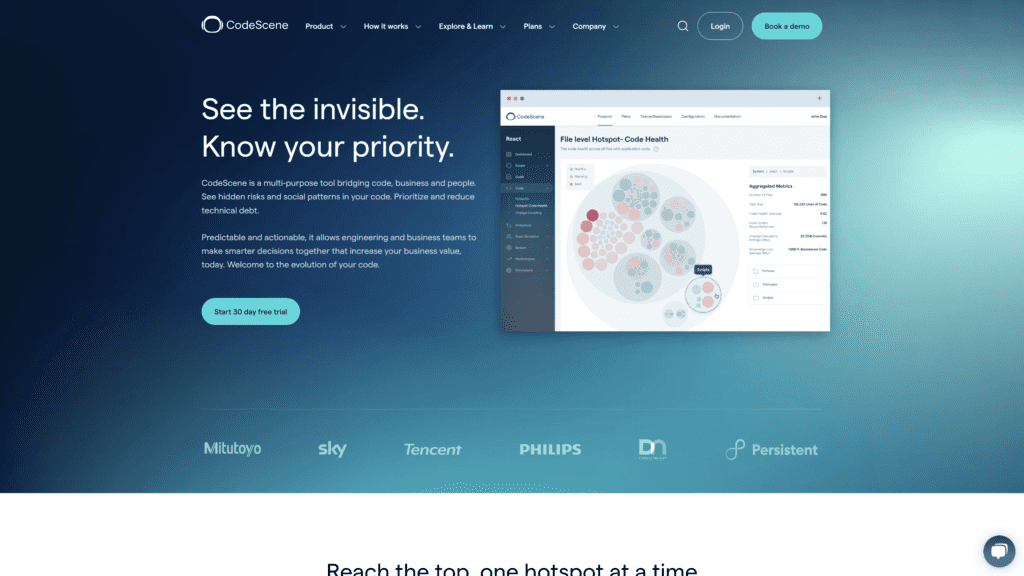
Overview
CodeScene differs from other options on this list because it’s a multipurpose tool for bridging codes and helping people who know nothing about code review and development.
Not only does it help you develop and perfect your code, but it also helps to find social patterns in your code to improve the user interface and detect hidden risks.
★★★★☆
Best Multipurpose Platform
Notable Features:
- Cloud and On-Premise Hosting: You can choose whether you want to use this code review tool via a cloud or on-premise with your team in person.
- Analytic Reports: Not only will this help you fix bugs in the code, but it will also help you optimize your code to be user-friendly and socially engaging.
Charts and reports can help you understand where changes should be made and what is working effectively. - CodeScene React: The React feature is a JavaScript library that gives users access to interface templates and updated building tools.
This feature allows you to try all sorts of tools on your code to see what works best for your needs.
Pros
- Works with 25+ programming languages
- Focuses on optimizing, not just editing
- Easy-to-use platform and dashboard
- Excellent customer service
- Improves productivity
- Useful visuals
Cons
- Trouble integrating with CI/CD tools
- Can be hard to derive conclusions from analytics
- More expensive
Is CodeScene Hard To Use?
No, CodeScene is easy to use.
Not only is it intuitive and user-friendly, but it also has tons of tutorials, resources, and customer representatives to help you understand the platform.
Pricing & Plans
You can choose from a Standard plan, Pro plan, or Enterprise plan.
But there is no free option.
Standard: This plan costs about $20 per month for every active user.
It comes with analytical tools, quality gates, and everything else you need to reduce mistakes and bugs in your code.
Pro: This plan costs about $30 per month and user, and it comes with more features like social analytics, Jira integration, PDF charts and reports, and more.
Enterprise: The Enterprise plan is typically ideal for large teams and businesses rather than small companies and individuals.
Enterprise plans have a custom price based on the user’s needs, so you have to contact CodeScene for a quote.
Our Take
CodeScene goes beyond just editing and reading code for mistakes.
Rather than just finding bugs, it will give you advice and information to help you improve your code for usability and appeal.
The prices are more expensive than other code review tools, but the added features are worth it!
Reviewable
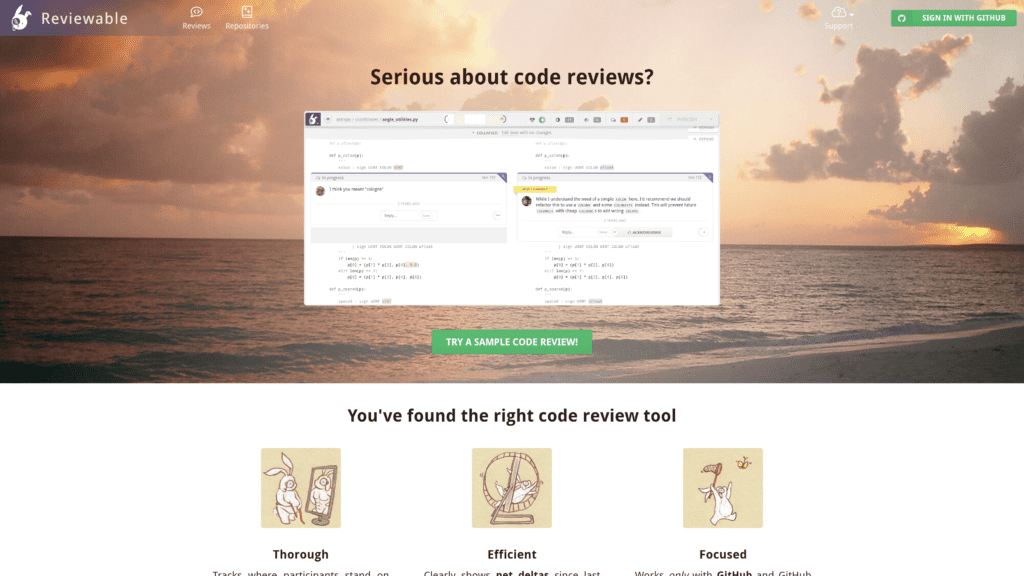
Overview
Reviewable is specifically for Git hosting and coding.
It’s excellent for reviewing changes and monitoring your team’s progress.
At any time, you can compare different versions of a code with their clear user interface and customizable dashboard.
★★★☆☆
Best for Tracking Progress
Notable Features:
- Customizable: With Reviewable, you can customize margins, fonts, colors, keyboard shortcuts, comment thread displays, and more to make it more personal and user-friendly.
- Tracked Versions: The main feature people like about Reviewable is the ability to closely track and compare different versions of the same project.
This is the perfect tool to help managers and business owners monitor a project’s progress and what their team is working on. - Modern UI: The user interface of Reviewable is super easy to use and even fun!
Not everyone loves this feature, but it’s impossible not to notice the whimsical nature of the platform.
Pros
- Easy integration with GitHub
- Easy for developers and newbies
- Keeps everything on Git accounts
- Excellent for tracking progress
- Helps implement code after review
- Fast code review
Cons
- Poor user-interface
- Busy website
- Unnecessary features
Is Reviewable Hard To Use?
Reviewable’s interface is not the best, and some may even call it messy.
Using the feature is straightforward, but navigating the website itself can be more challenging.
Pricing & Plans
You can choose from the free plan, the organization plan, or the enterprise plan.
Free: The free plan is excellent, offering public repositories, personal repositories, unlimited reviews, and more!
Organization: This is a great choice for larger teams that want to keep their code review affordable.
It costs $39 a month for ten users, unlimited reviews, and private repositories.
This is the most popular plan but also the most expensive offered by Reviewable.
Enterprise. The Enterprise costs $17 per user every month, making it a more affordable choice compared to other enterprise plans.
It’s also supported by Slack and can work on-premises or via a cloud.
Plus, you get automatic invoiced billing for convenience!
Our Take
While the fun display is cute and the customization is nice, this is one of the weaker code review tools.
The actual code review can lack efficiency and focus.
But for someone who wants something affordable that will do a decent job, Reviewable is a suitable choice.
Veracode
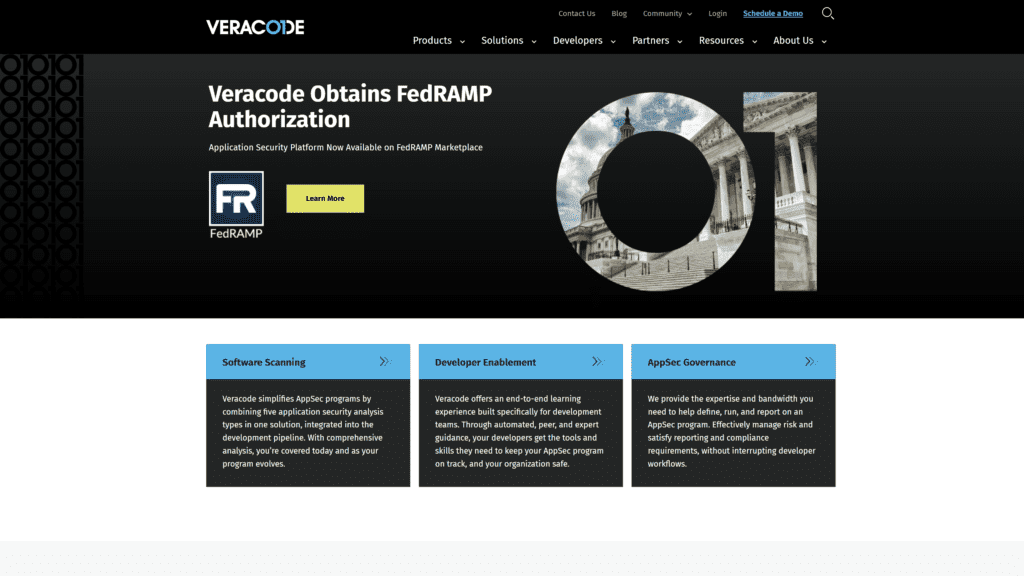
Overview
Veracode is a fantastic code review tool for people who want to get to the core of their code.
Like Reviewable, Veracode goes beyond just editing and perfecting your code.
It also helps you to optimize it and attain reports that can help you to discover where the code works and where it can be improved.
★★★☆☆
Best for Analysis
Notable Features:
- E-Book: Along with their excellent features and tools, Veracode also offers a free e-book you can download.
It has tons of information on coding and perfecting your code, so it’s a wonderful resource to have if you’re still learning about coding. - Software Scanning: You can easily combine five applications with a security analysis to review one code.
This comprehensive analysis means your code can evolve with the times, staying as modern and user-friendly as possible. - Developer Enablement: This offers end-to-end learning tools, so you can feel confident in your code. The experience of Veracode’s developer enablement feature will help your team perfect the skills and tools they need to keep the project on track and organized.
- AppSec Governance: This feature from Veracode gives you access to the bandwidth and expertise you need to create a successful AppSec program to track code progress.
It helps you to manage risk while satisfying compliance requirements.
Pros
- Added developer mitigations and comments
- Excellent automation
- Predicts future vulnerabilities
- Cloud-native SaaS Architecture
- Market expansion tools
- Support staff are helpful
- Tools are efficient
Cons
- Can generate false positives
- UI changes often
- The scanning process could be better
Is Veracode Hard To Use?
No! Veracode is super easy to use!
The user interface is clean and easy to navigate, making it one of the best code review tools for anyone and everyone.
If you want something that you’ll be able to figure out quickly so that you can get to reviewing as soon as possible, Veracode may be your best bet!
Pricing & Plans
Unfortunately, Veracode has very elusive pricing.
They do offer a free plan you can take advantage of, but there is a premium option with added consulting services, which are very useful.
While the pricing for the premium services is hard to find, and you need to contact them for a quote, most users report it’s expensive.
Veracode has great features but can cost $150 a month or more.
Our Take
While Veracode has useful features and incredible analytics, it might not be worth it.
Not only are their prices not transparent, but they also tend to be high.
The features are undeniably helpful and well-made, but you can find similar features for a much lower price from one of the code review tools on this list.
Rhodecode
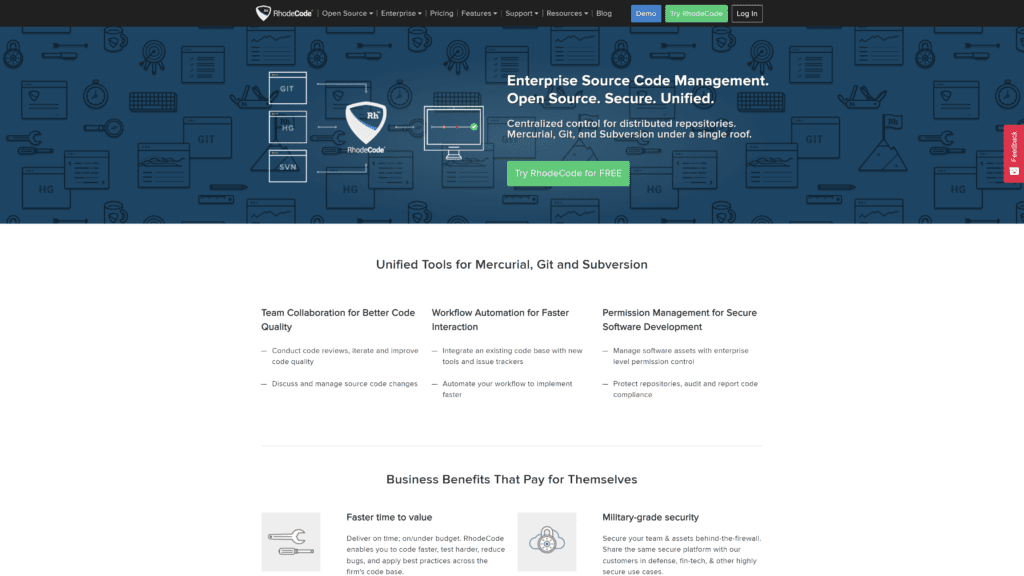
Overview
Rhodecode offers intelligent code reviews and a bundle of modern features that can help you build the perfect product and catch any mistakes in your code.
It works with Mercurial, Git, Subversion, and more.
This open-source repository management platform works well for accomplished developers and people new to coding.
Rhodecode is one of the most secure code review sites, so you can feel confident that your data and projects are kept safe.
★★★☆☆
Best for Security
Notable Features:
- Online Editor: With this, you can browse, delete, edit, and create files within the platform.
It allows you to keep everything more organized so that your team can stay on top of project changes and progress, and it supports most coding languages. - Binary File Support: Rhodecode’s large binary file support is one of the best storage services of any code review tool, with its extensive security firewalls.
It can store videos, images, and other assets so that they are safe and sound! - Active Breakthrough Prevention: This aspect of Rhodecode validates users, commits messages with custom extensions, and prevents unwanted data from entering your repositories.
If any suspicious activity is detected, your data is automatically locked. - Compliance and Auditing: Along with data protection, Rhodecode also provides data aggregation, data reporting, and analysis tools.
This ensures your company meets any compliance requirements.
Pros
- User-friendly
- Interactive developer community
- Extremely secure
- Cross-platform integration
- Effective code review
- Side-by-side version comparisons
- Web-based editing capabilities
Cons
- Slow development and reviewing
- Limited experimentation capabilities
- Additional fees and costs
Is Rhodecode Hard To Use?
Rhodecode is easy to use! Some code review tools are a bit more user-friendly, but Rhodecode is generally intuitive.
For general code review, it’s a breeze, but when using more complex features, some elements can become confusing.
Pricing & Plans
Rhodecode has three pricing plans to choose from, including a free option!
Community: Rhodecode Community is a free subscription for people who want to take advantage of community support, code review tools, on-premises deployment, user access controls, full-text search, code indexing, and more.
It’s one of the best free plans offered by a code review company.
Enterprise: Enterprise is the most expensive plan, costing $75 a month for each user.
However, there are multi-year discounts available to some people.
With this plan, you get more scalable code tools, faster code reviews, tech support, predefined integrations, and parallel running tools.
It’s best for larger companies with teams of at least 10 people who need access.
Cloud: The Cloud plan is new from Rhodecode, costing only $8 a month for every user.
But not everyone can sign up for this plan, as Rhodecode has to approve the plan and only does so for larger companies.
But it gives you all Enterprise features plus more storage and security.
Our Take
Rhodecode has decent code review tools and helpful features.
But if you want something that will protect your data and keep your projects secure, Rhodecode is the best option.
They consistently upgrade firewalls and block backdoors, ensuring no one can access your content.
If your code is highly sensitive and you want to ensure no one can steal it, you can trust Rhodecode.
Types of Code Review Tools
This section will briefly discuss the five main types of code review that every developer should know.
Even if you’re not a developer but work on projects with code, having an idea of different types of code reviews that various review tools can run.
Audits
Audits are when code is reviewed to ensure it complies with all standards, guidelines, regulations, and laws.
A code that does not comply with these rules can lead to legal problems.
Not all code review tools can run an audit like this, but some can.
A prime example is Rhodecode, as some of their features work to audit code while reviewing it for mistakes.
However, audits are often one of the last steps of code review.
Management Reviews
A management code review concerns project managers or team leaders.
Most code review tools have a feature that can assist managers and leaders in tracking the progress of a code.
Tracking changes and comparing differences between versions is an essential type of code review, as it gives an idea of the time it takes to review code and improve it.
These are the rarest of reviews, but the proper code review tools have features that make it easier for managers to do this.
Technical Code Reviews
Technical code reviews are the most common type of code review and the best used for code review tools.
These code reviews search for bugs and other errors but can be time-consuming and tedious.
Automating this type of code review can save your team loads of time, and all of the code review tools on this list can perform this task.
Technical code reviews ensure the code complies with the project specifications and can function.
Inspections
Inspections are similar to technical code reviews.
However, inspections are typically run after technical code reviews and require a more careful eye.
Luckily, these inspections can be run by code review tools in conjunction with a developer’s oversight.
These are sometimes called PR code reviews too.
Inspections usually offer options for improvement or enhancement, which not all code review tools can do.
Suggestions for improvement typically require some form of AI within the code review software.
Walkthrough
A walkthrough takes place after an inspection.
Walkthroughs are like inspections but perform closer to the completion of the product.
Therefore, walkthrough code reviews are often slower and more focused on certain aspects.
The best code review tools have walkthrough capabilities, but coders typically perform part of this review themselves to ensure quality and accuracy in the code.
However, code review tools can perform this action for people who don’t have advanced coding and reviewing skills.
Features To Look for in Code Review Tools
As you can see from this list, you can choose from several code review tools.
But not all are created equally.
There are several factors to consider when choosing the best code review tool.
You don’t want to pay more than you have to to keep business costs down, but you also don’t want to waste your money on a cheap product that performs poorly.
Regard the below considerations when choosing a code review tool from the options above.
While we consider Bitbucket to be the best overall, individuals and businesses prioritize features differently.
Consider what the most important aspects are for you.
Flexible and Easy-To-Use
Two aspects to keep in mind are flexibility and ease of use.
Even if you’re an experienced developer, thoroughly reviewing code and making changes can be challenging and frustrating if the interface is poor.
How can you appreciate a code review tool’s features if you can’t figure out how to use them?
If you don’t consider yourself an expert at tech and coding, select a code review tool that is super user-friendly.
In addition to ease of use, you also want a code review tool that has some flexibility and allows you to customize to a certain degree.
Not every project can work with a cookie-cutter code review tool.
If your coding projects are particularly niche, choose a platform you can personalize to suit your needs.
Hardware and Software Requirements
Ensure you have the proper hardware and software for the tool you want to use. Some code review tools are software themselves.
In these cases, you need certain hardware and storage to download and operate the software.
Other code review tools are online platforms, but you still need modern hardware and software for these sites to function.
Before purchasing any software or subscription plans, review the tool’s requirements for hardware and software.
You may need to buy new hardware, but in most cases, you can find a code review tool that works with what you already have.
Customer Support
One of the most troubling aspects of code review tools is customer support.
Some have impeccable customer support teams that can walk you through features and help you get settled.
But others have poor customer service teams who are tricky to reach and don’t offer much help.
Accomplished developers and coders may not necessitate an excellent support team, which can save them money.
But for people who want to ensure they have someone who can help them navigate their code review tool, it’s best to choose a code review tool with a strong support team behind it.
License Cost
Last but certainly not least, you need to consider the price of the subscription or software license.
This article outlines the different pricing plans offered by the best code review tools to help you decide on your code review budget.
Determining your budget will also involve the number of users and how much code you plan to review.
But in general, try to pick the code review tools that offer the most bang for your buck and suit your specific needs.
Frequently Asked Questions

Do you have more questions about code reviewing and tools?
Code review can be a dizzying topic but necessary for developing successful projects and reaching consumers effectively.
Read the frequently asked questions below to understand why code review is valuable and how helpful it can be.
Why is code review critical?
There are many reasons why code review is critical.
The top reasons to use a code review tool are to help developers learn the code base, understand new technologies, and perfect the code before the project launches.
You wouldn’t publish a book without editing it for grammar, and reviewing your code is no different.
Allowing unreviewed code into the world can ruin a company’s reputation and frustrate consumers and users.
How do you perform a code review?
Performing a code review manually can be taxing.
There are different ways to do this and various techniques you can implement.
However, no matter what kind of code review you perform, set standards for the project and code.
Expectations allow the developers to review the code within the project guidelines and deliver the best product.
But manually reviewing code is time-consuming, so using code review tools is more efficient.
How does code review help minimize errors?
Code review helps minimize errors by allowing team members to share knowledge and responsibility for the project.
Not only does a code review skim for bugs and mistakes, but the tracked logs and changes help everyone understand what’s being done wrong and what’s being done right.
Code review tools alone can help polish code, but they also help your team understand the project better and how to
Conclusion
The top reasons to use a code review tool are to help developers learn the code base, understand new technologies, and perfect the code before the project launches.
You wouldn’t publish a book without editing it for grammar, and reviewing your code is no different.
Allowing unreviewed code into the world can ruin a company’s reputation and frustrate consumers and users.
How do you perform a code review?
Conclusion
All 13 of these code review tools have something to offer.
Whether you’re an advanced developer, a newbie business owner, or an individual trying to perfect their code, using a code review tool is crucial.
While manual code review is always an option, it’s an exhausting and extensive process that delays productivity.
While each code review tool on this list is ideal for someone, we think Bitbucket is the best code review tool for most people.
It offers affordable plans, excellent code reviews, and exciting features to help you find success.
GitHub is another you should consider if you’re trying to perfect your code.
But any options on this list will help you drastically improve your code!
So, don’t waste any more time manually reviewing code when these handy tools can do it for you!







